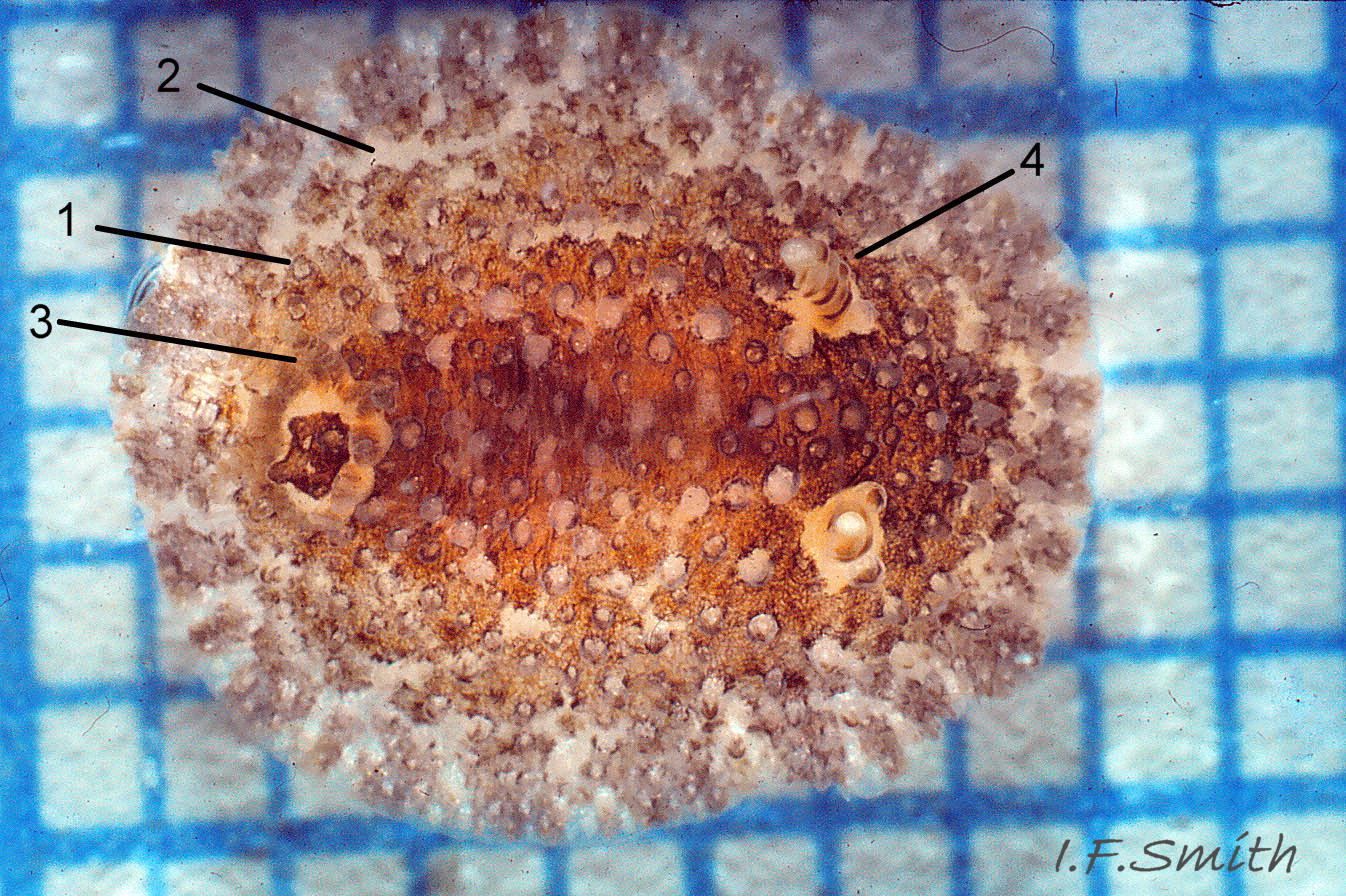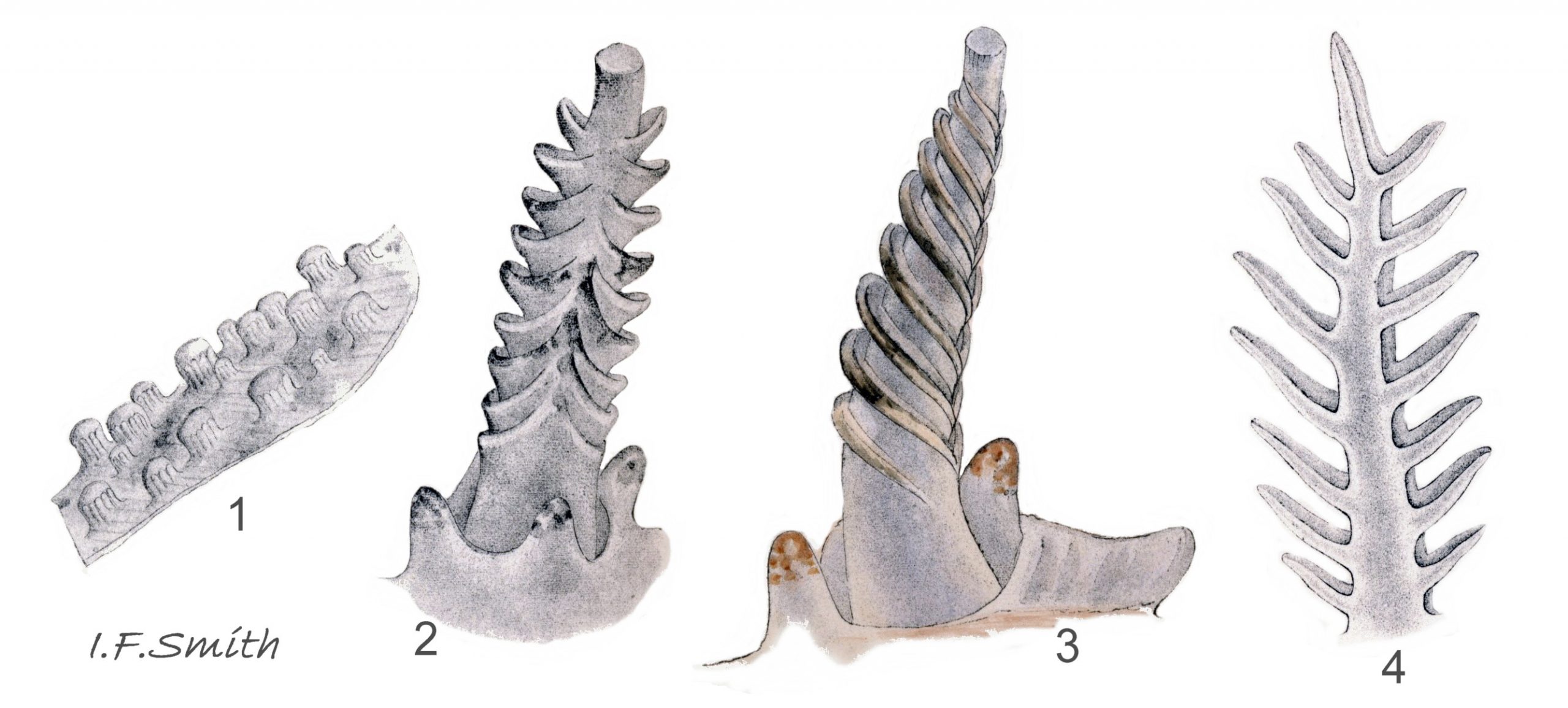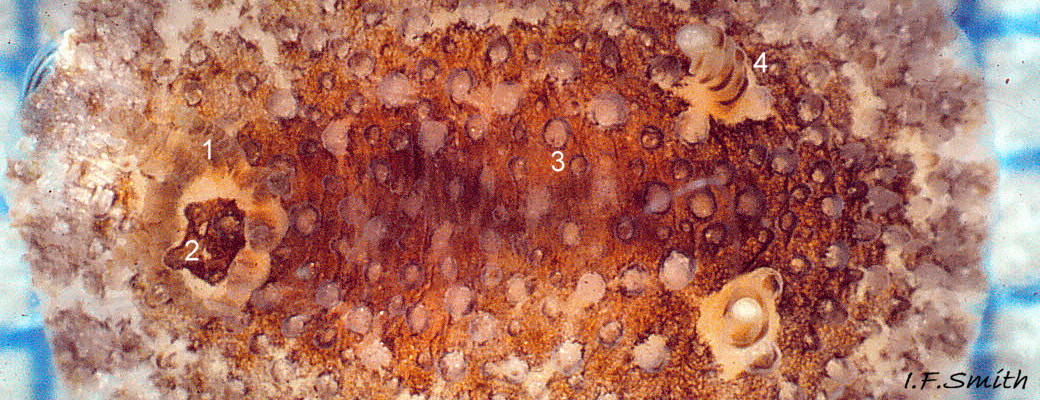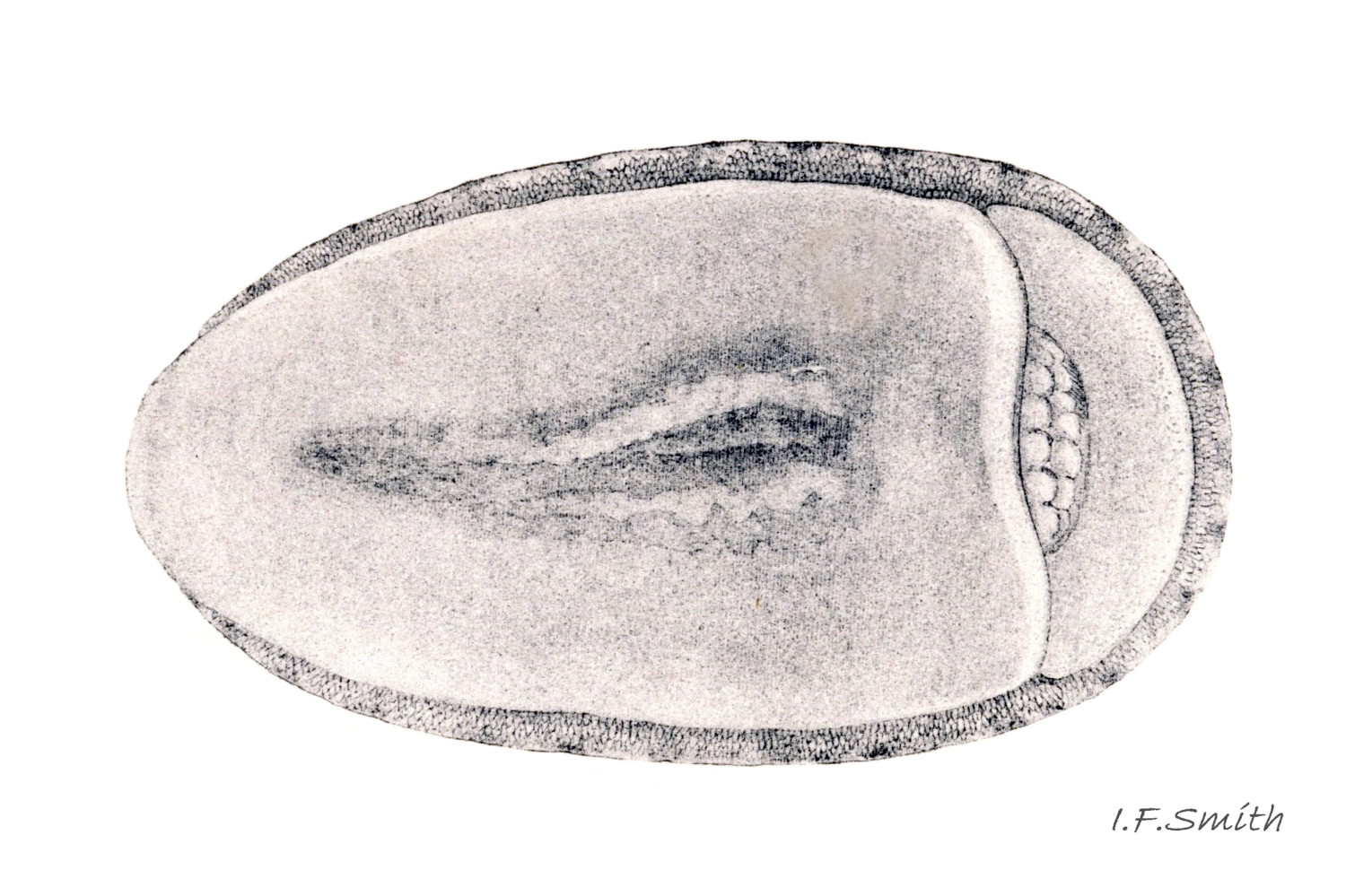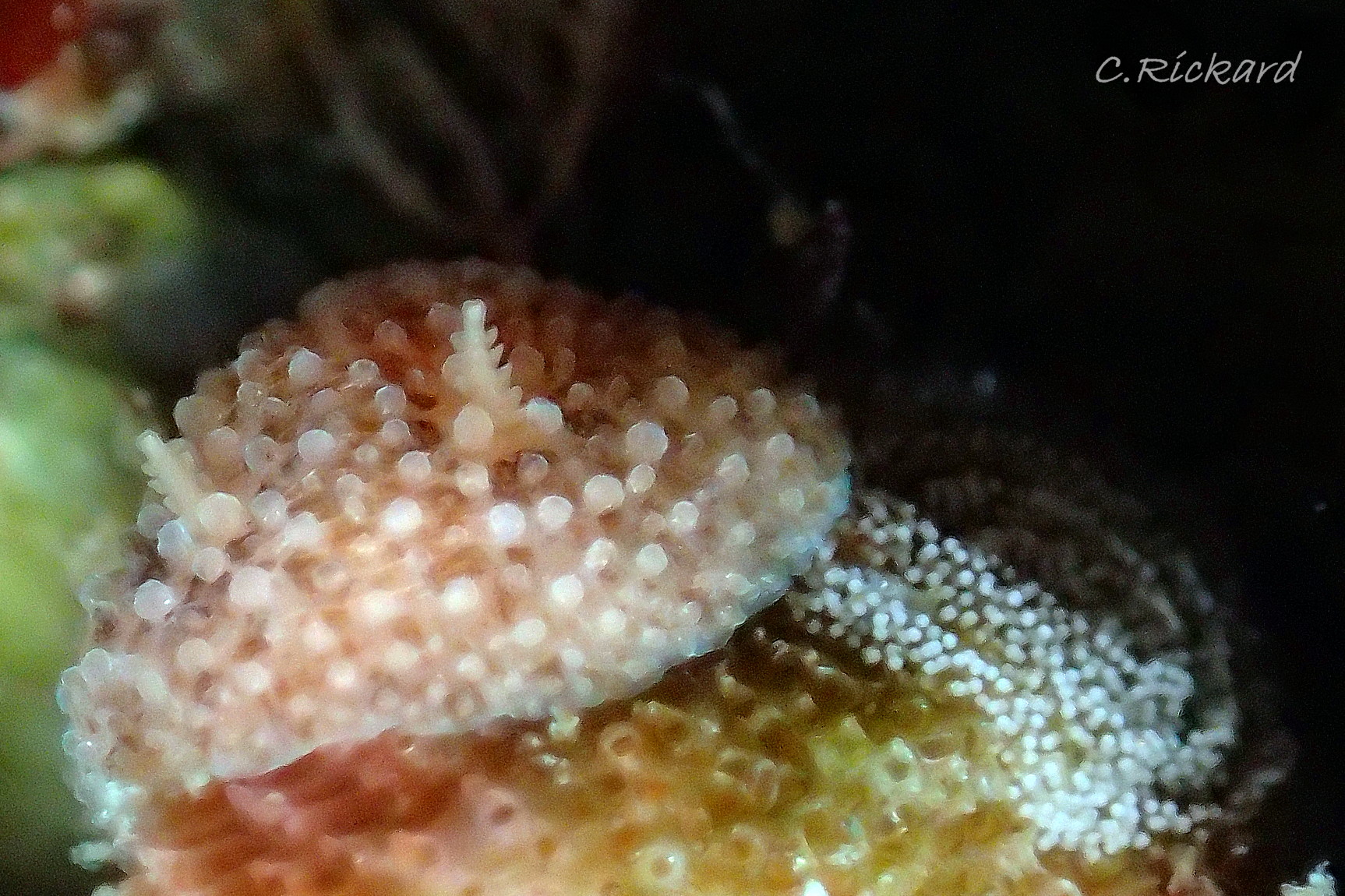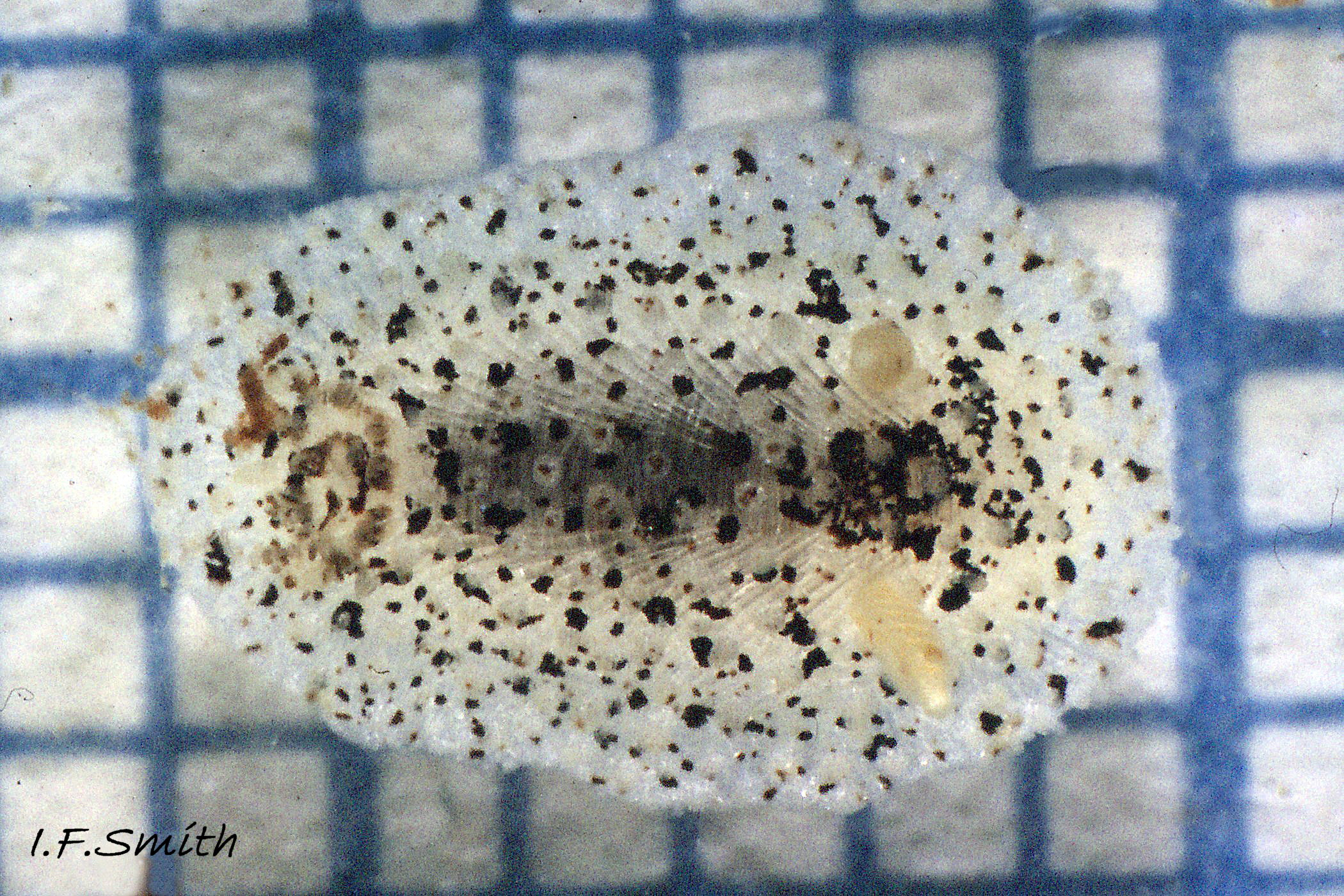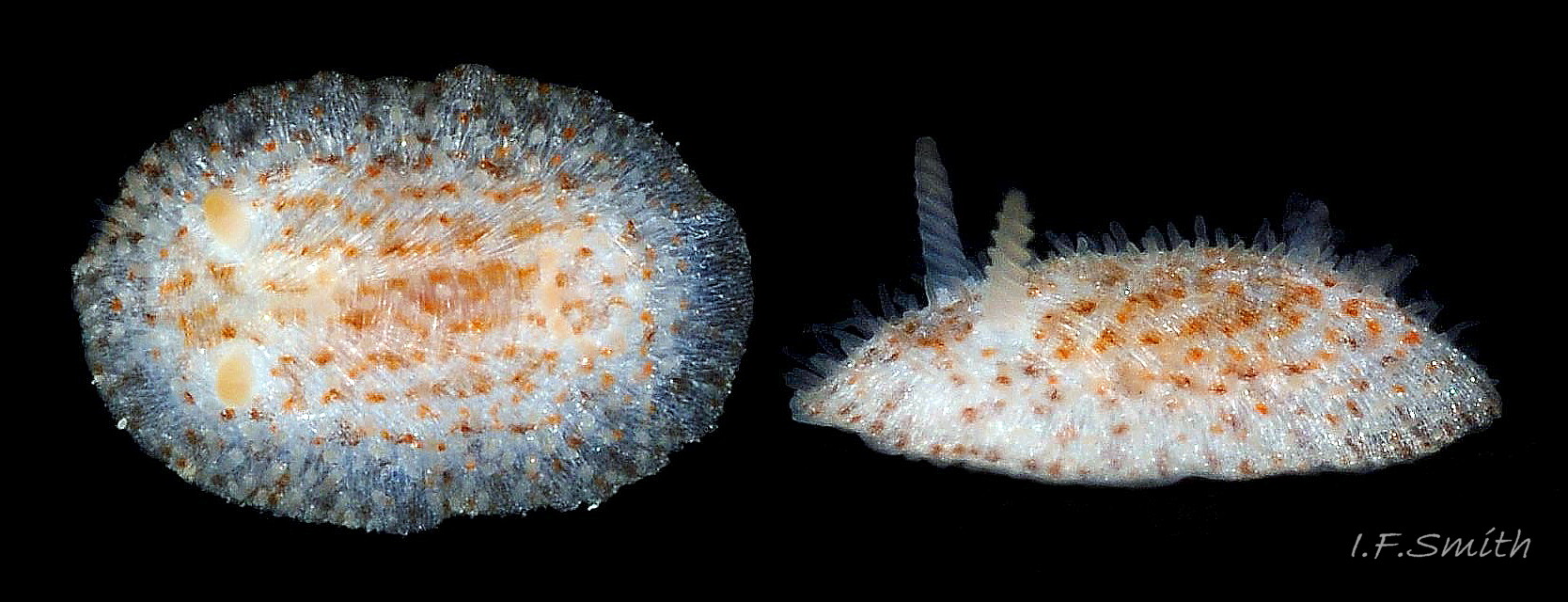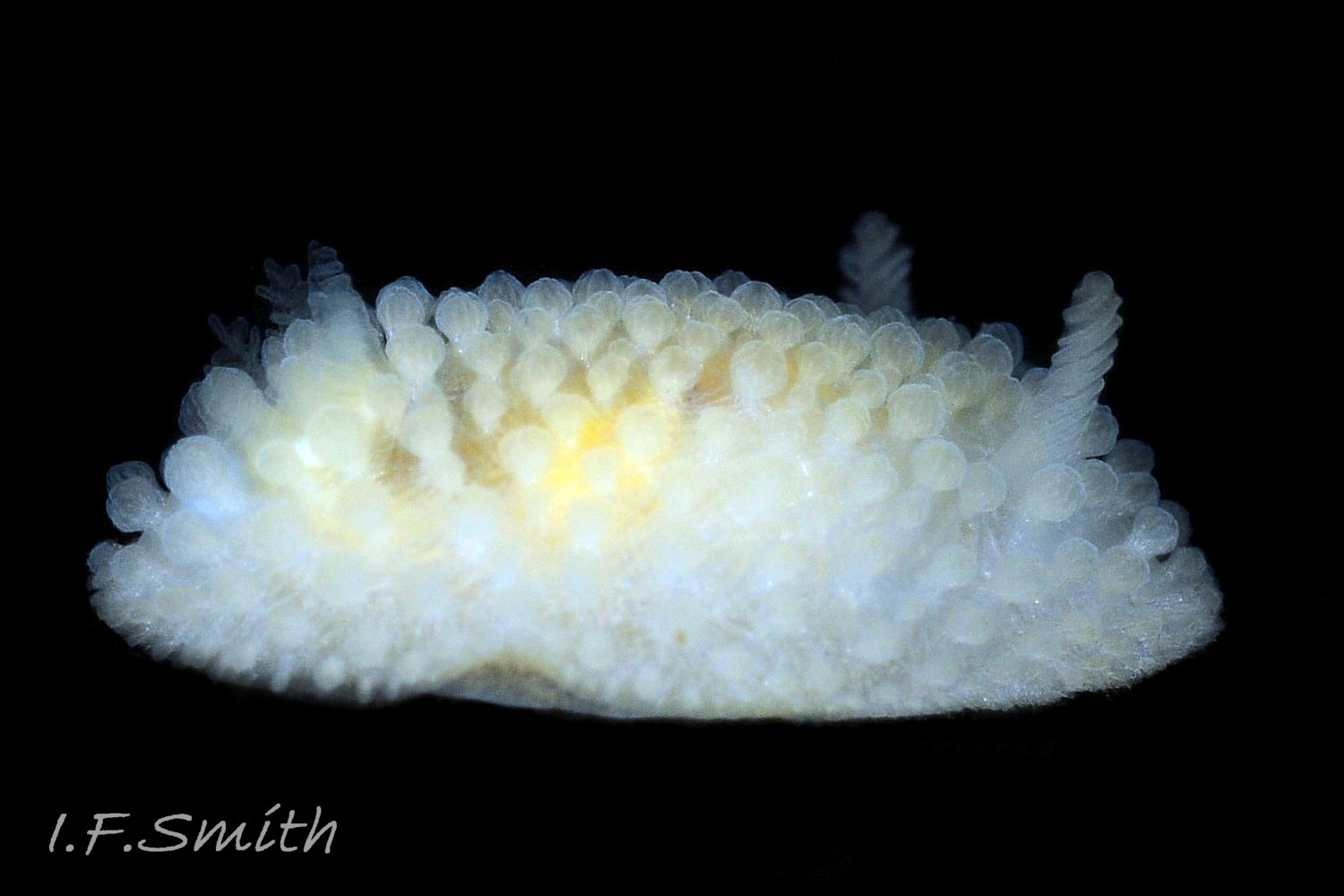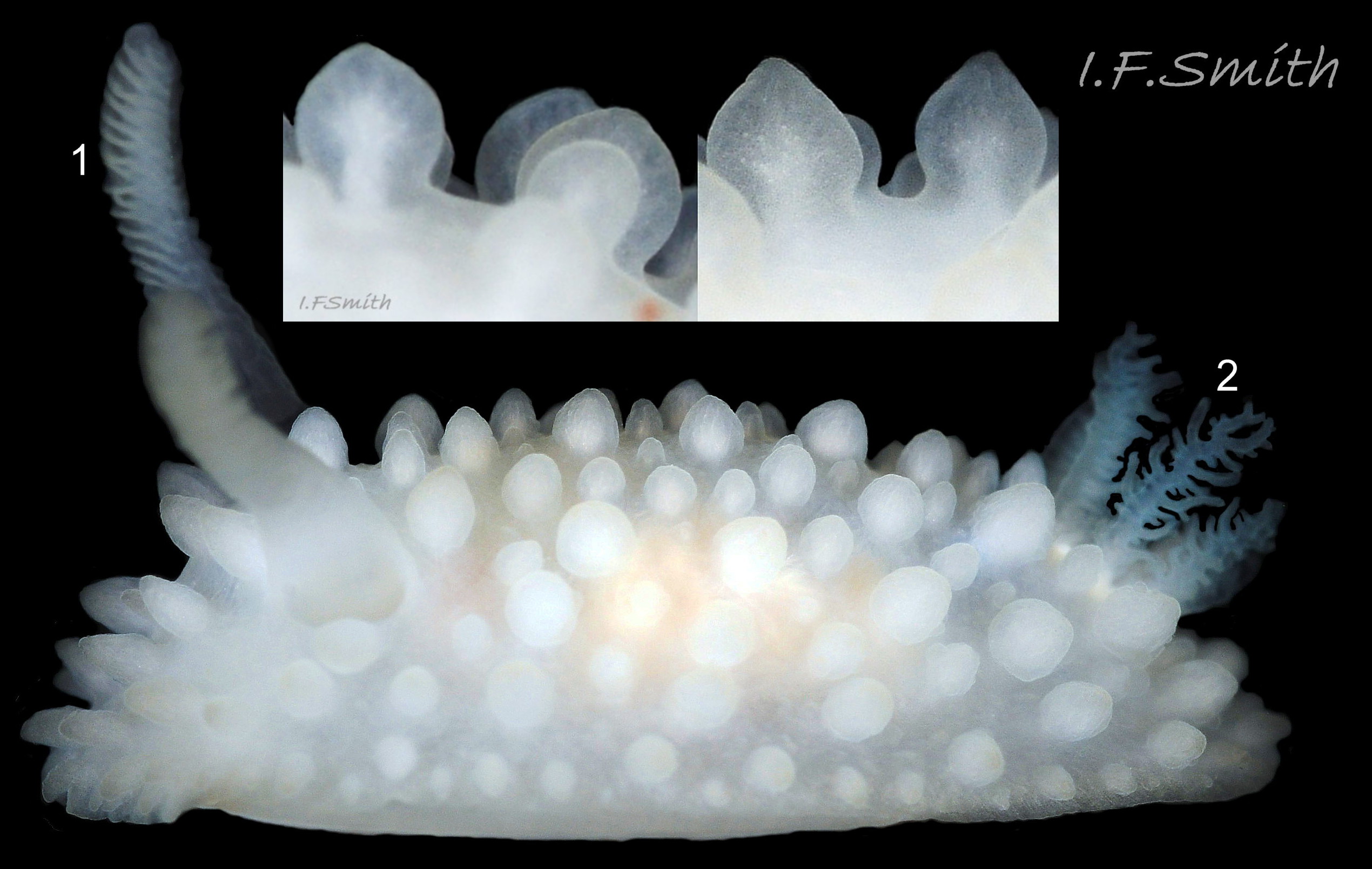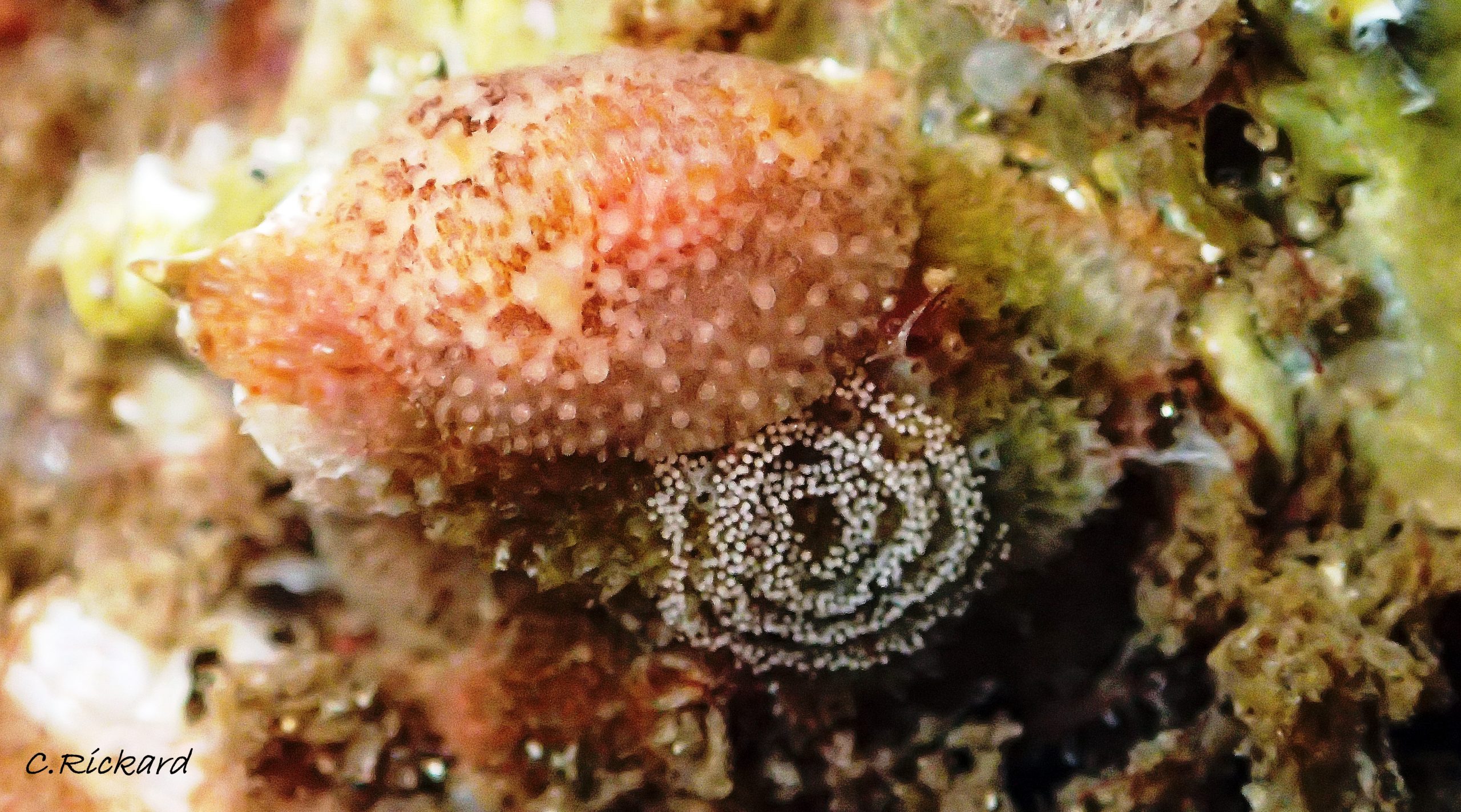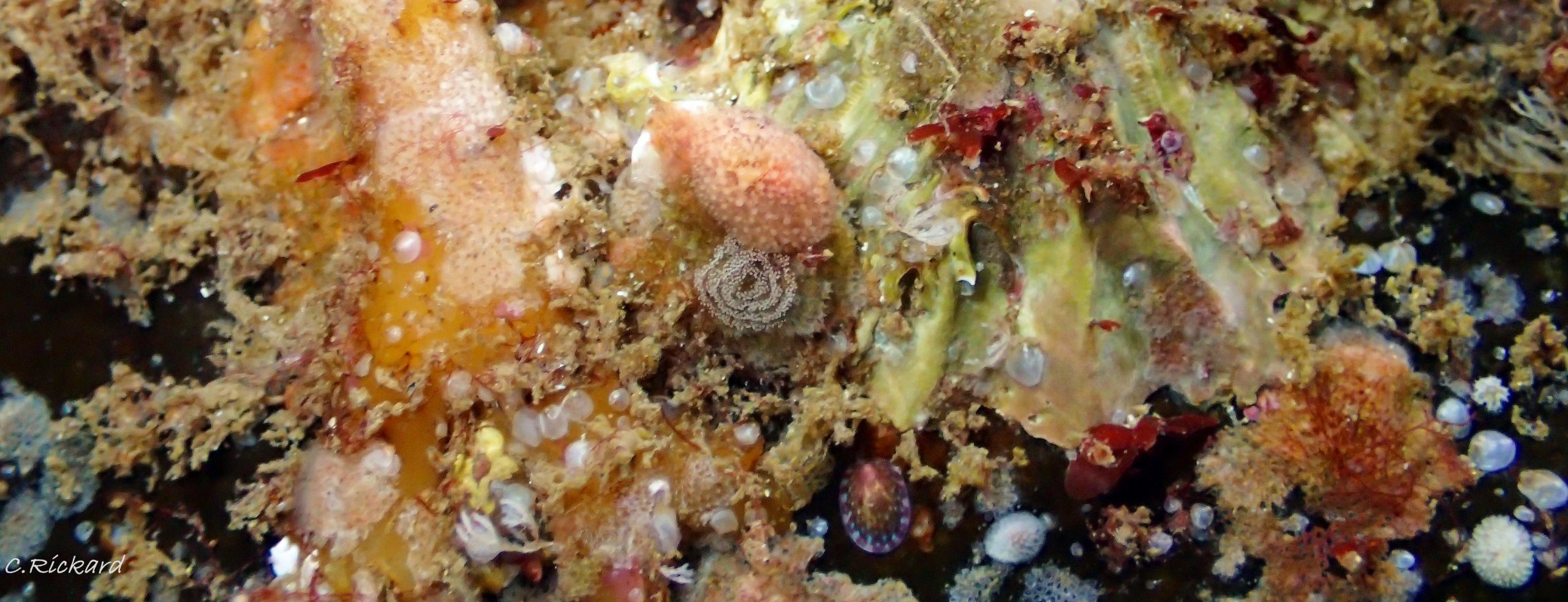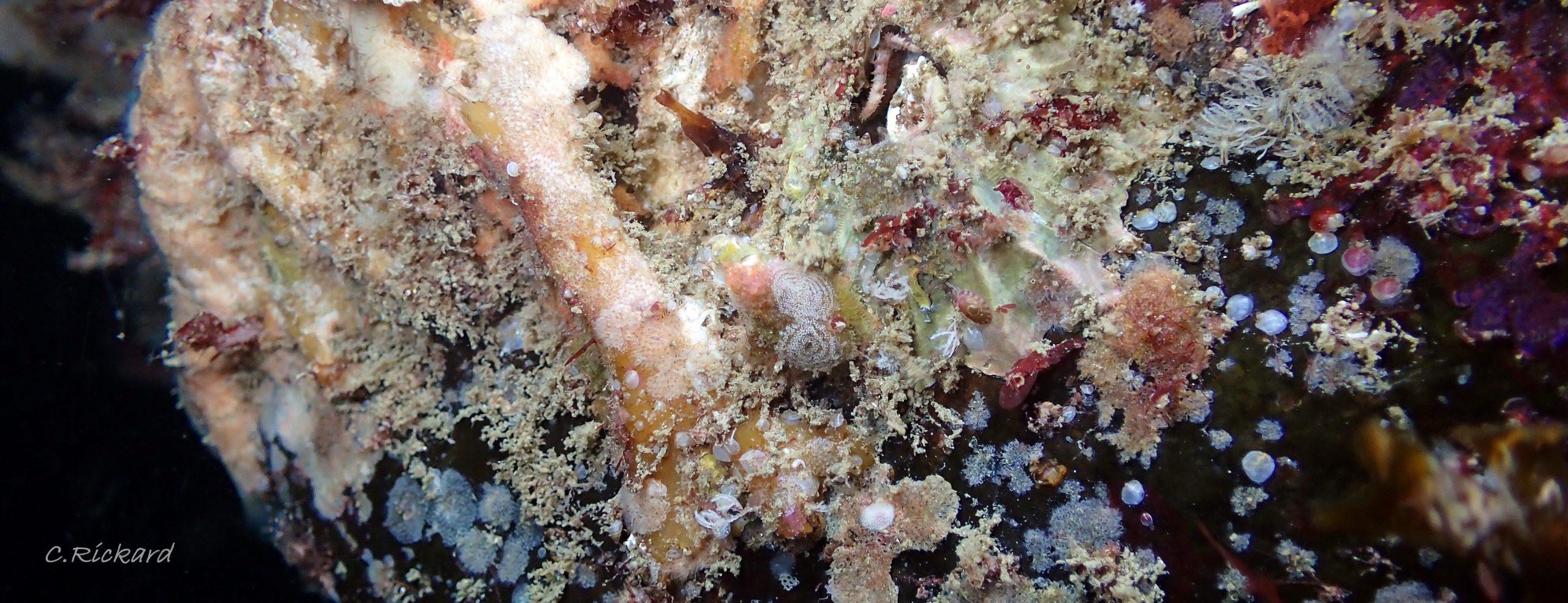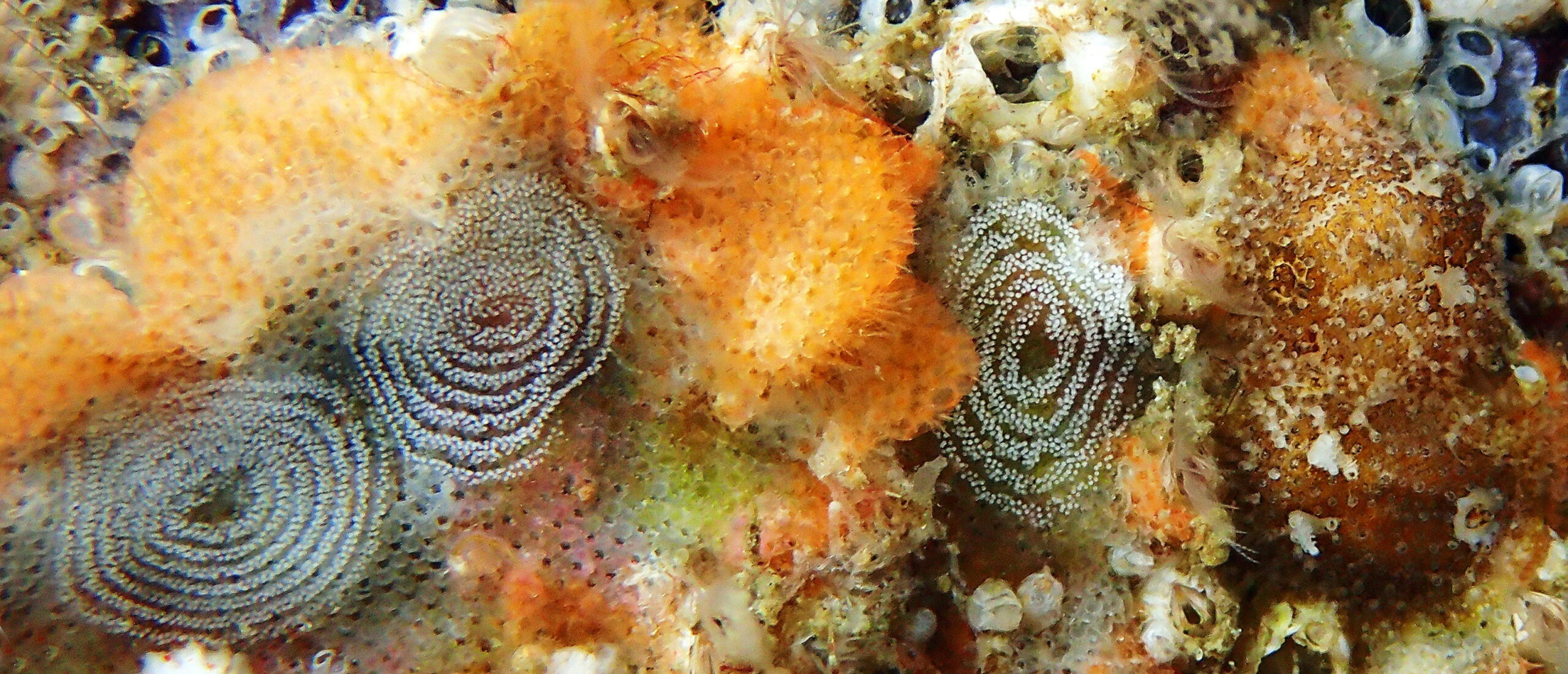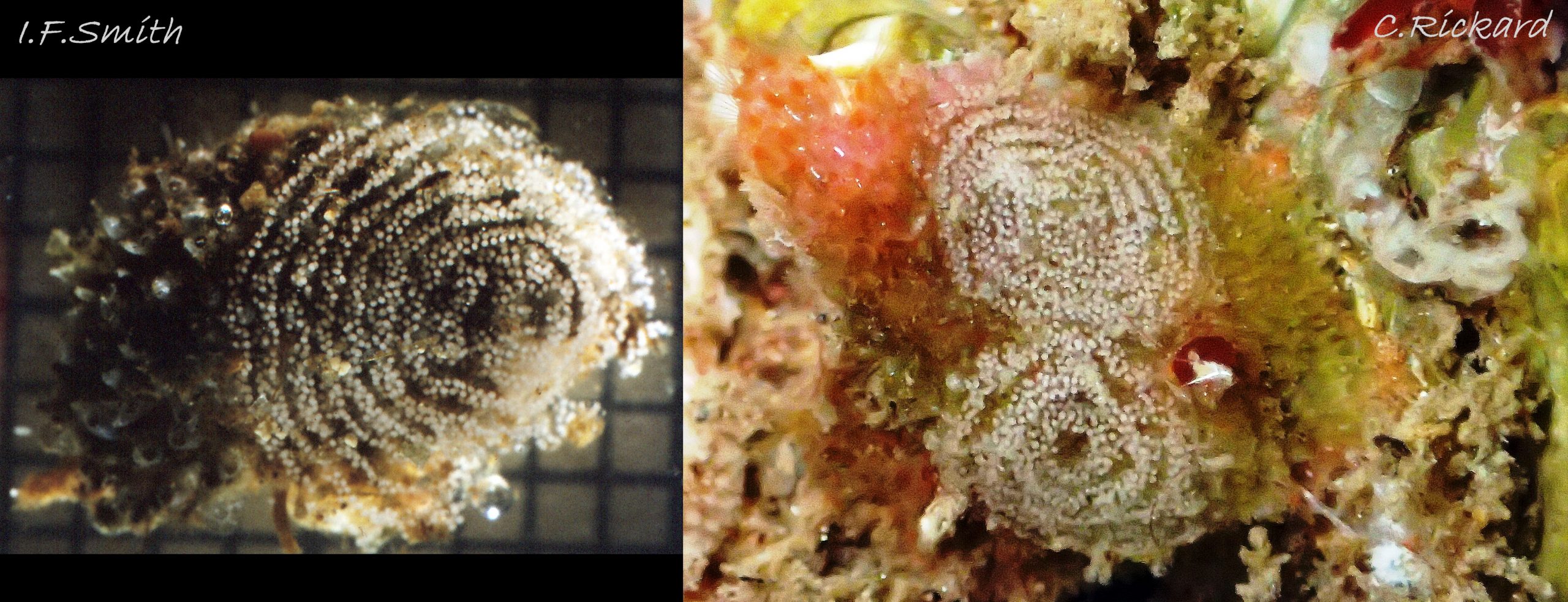Click image to enlarge with full caption. Main text below slider.
Atalodoris sparsa (Alder & Hancock, 1846)
Synonyms: Doris sparsa Alder & Hancock, 1846; Onchidoris sparsa (Alder & Hancock, 1846); Knoutsodonta sparsa (Alder & Hancock, 1846).
Meaning of name:
Atalodoris = (Greek) Young Doris (name of a sea nymph).
sparsa = (Latin) sprinkled/ splashed.
Current taxonomy: World Register of Marine Species (WoRMS) https://www.marinespecies.org/aphia.php?p=taxdetails&id=1565665
GLOSSARY below.
Body description
A. sparsa grows up to 8 mm long. From above it has a broad oval outline when in motion 01 Atalodoris sparsa , but is more discoid when at rest 02 Atalodoris sparsa . It has a low profile 03 Atalodoris sparsa . The mantle covers the whole body and its ground colour is pinkish white with large areas of brown pigment which may cover all the pinkish white except for the majority of tubercles and pink strap-like gaps between the blocks of brown 02 Atalodoris sparsa. The amount and intensity of brown varies; the illustration in Alder & Hancock (1845-1855) shows very little 01 Atalodoris sparsa but their illustration may have faded in c. 170 years. The orange-brown digestive gland often shows through the slightly translucent mantle as a darker dorsal zone extending from the gills to the rhinophores 02 Atalodoris sparsa. The mantle surface has many small, round topped, spiculose tubercles 04 Atalodoris sparsa & 05 Atalodoris sparsa . When viewed directly from above, the tubercles often show as a pale spot outlined by brown 06 Atalodoris sparsa , occasionally, they have a central greyish spot 05 Atalodoris sparsa .
The mantle is stiffened with many long, colourless, translucent, internal spicules; transverse dorsally and oblique laterally, orientated down towards the posterior 03 Atalodoris sparsa . In certain light, the spicules are externally visible 05 Atalodoris sparsa , and they may protrude from the mantle rim giving it a scaly appearance when viewed ventrally 07 Atalodoris sparsa . The pale translucent rhinophores have a truncated apex and up to nine widely spaced, oblique lamellae which may have dark pigment 04 Atalodoris sparsa & 06 Atalodoris sparsa or not 08 Atalodoris sparsa . Around the base of each rhinophore, there are three or four large splayed tubercles; they and a smooth patch behind the rhinophore 01 Atalodoris sparsa, 04 Atalodoris sparsa & 06 Atalodoris sparsa are distinctly lighter, or sometimes darker, than the adjacent mantle.
There are up to 10 simply pinnate 04 Atalodoris sparsa, translucent, often grey-brown gills 06 Atalodoris sparsa arranged in a horseshoe which encloses black-brown tubercular processes and the anus. The head has a large oral veil and a large depression around the mouth 07 Atalodoris sparsa . The foot is nearly as wide as the mantle. Its sole is translucent whitish, showing the central, elongate, orange-brown, or brownish-salmon, digestive gland 07 Atalodoris sparsa . The anterior of the foot is truncate and may have a shallow curve back from mouth.
Key identification features
Atalodoris sparsa
1) Usual maximum length 8 mm.
2) Mantle usually brown, peripherally dissected into blocks by pinkish white gaps 02 Atalodoris sparsa.
3) Around the rhinophore base, the large tubercles and smooth patch behind the rhinophore are distinctly lighter 01 Atalodoris sparsa or darker, than the adjacent mantle.
4) Up to nine widely spaced lamellae on each rhinophore 04 Atalodoris sparsa .
5) Tubercles may appear as pale spots with dark outline 06 Atalodoris sparsa .
6) Orange-brown digestive gland visible through sole 07 Atalodoris sparsa .
7) Spawn a polygyrous spiral on Cellepora pumicosa and Porella concinna in August (N.E. Scotland) and possibly other months.
Similar species
Atalodoris inconspicua (Alder & Hancock, 1851) 09 Atalodoris sparsa
1) Maximum recorded length12 mm.
2) Scattered random brown freckles, and often black flakes, on mantle.
4) Up to 14 close set lamellae on each rhinophore.
5) Abundant small round-tipped tubercles on mantle (not swollen or club-shaped).
7) Spawn a polygyrous spiral on Cellepora pumicosa and Porella concinna (same as O. sparsa); in March (Northumberland), May (Orkney) and possibly other months 18 Atalodoris sparsa .
Atalodoris depressa (Alder & Hancock, 1842) 10 Atalodoris sparsa
1) Maximum length 9 mm.
2) Orange/brown pigment spots arranged in longitudinal lines on mantle.
5) Long, soft, non-spiculate tubercles on mantle.
7) Spawn a polygyrous spiral, probably on Schizomavella linearis
8) Very depressed profile.
Atalodoris oblonga (Alder & Hancock, 1845) 11Atalodoris sparsa
1) Usual maximum length 8 mm, occasionally 12 mm.
2) Mantle white or pale grey with a few randomly scattered brown or black blotches.
4) Up to 14 close set lamellae occupy whole of each rhinophore apart from a very short stem.
5) Translucent conical tubercles are taller than on A. sparsa.
6) Orange-brown liver visible through sole.
7) Feeds on branched bryozoan Celleria fistulosa. Spawn mass a rounded lump on branches of C. fistulosa; not spiracular.
8) Often extends into a long form narrower than that of other similar species, but can contract into a shorter shape when it is noticeably higher in profile than other Atalodoris spp.
Onchidoris muricata (O.F. Müller, 1776) 12 Atalodoris sparsa
1) Usual maximum length 14 mm.
2) Usually, no dark pigment marks on dorsal surface.
4) Lamellae on rhinophores more closely spaced than on A. sparsa.
5) Tubercles shaped as club with flat/slightly rounded tip.
7) Spawn a spiral of two or three coils on a wide variety of encrusting bryozoans.
Adalaria proxima (Alder & Hancock, 1854) 13 Atalodoris sparsa
1) Usual maximum length 17 mm.
2) Usually, no dark pigment marks on dorsal surface.
4) C. 18 lamellae on rhinophore when L. 15 mm, more closely spaced than on A. sparsa.
5) Tubercles, torpedo shaped club with rounded point.
7) Spawn an angular spiral on Electra pilosa and some other encrusting bryozoans.
Habits and ecology
A. sparsa is usually found in the in vicinity of its food organisms under rocks on shores at ELWS, and on rock surfaces sublittorally. It feeds on the encrusting bryozoans Cellepora pumicosa and Porella concinna. Breeding: Thompson & Brown (1984) stated, “Details of the reproductive cycle are unknown.”, but in January 2015 and August 2017 Chris Rickard photographed specimens and spawn on Cellepora pumicosa 14 Atalodoris sparsa on sublittoral, vertical rock faces, at c. 8 m depth, at Macduff, N.E. Scotland 15 Atalodoris sparsa & 16 Atalodoris sparsa . These may be the first recorded spawn of the species. The observed mass was a thick ribbon, attached edge-on to the substrate 08 Atalodoris sparsa , in the form of a polygyrous, unconvoluted, tightly-coiled spiral of up to nine coils 17 Atalodoris sparsa . The spawn is very similar to that of O. inconspicua which also eats and spawns on Cellepora pumicosa and Porella concinna 18 Atalodoris sparsa . The extent of the spawning period beyond August is unknown, and it is not known if it has a planktonic veliger larval stage.
Defence: the small size, low profile, tubercles and pinkish white and brown mantle make A. sparsa difficult for predators and humans to detect it against Cellepora pumicosa. Even when located, it can be difficult to distinguish the slug from the bryozoan 14 Atalodoris sparsa .
Distribution and status
A. sparsa occurs in Orkney, southern Sweden, Britain and Ireland, and Brittany, GBIF map https://www.gbif.org/species/5190118 . There are scattered records around Britain and Ireland, but it is uncommon; UK NBN map https://species.nbnatlas.org/species/NHMSYS0021528525.
Acknowledgements
I thank Jørn Ari for use of images, David McKay and Simon Taylor for specimens, and Chris Rickard for information and the use of his images of A. sparsa spawning; possibly the first images and records of the spawn in c. 160 years since Alder and Hancock made the first description of the species.
Links and references
Alder, J. & Hancock, A. 1845-1855. A monograph of the British nudibranchiate mollusca. London, Ray Society.
http://www.biodiversitylibrary.org/item/131598#page/148/mode/1up &
http://www.biodiversitylibrary.org/item/131598#page/149/mode/1up
Picton, B. & Morrow, C. 2023. Nudibranchs of Britain, Ireland and Northwest Europe. Oxford, Princeton University Press.
Thompson, T.E. & Brown, G.H. 1984. Biology of opisthobranch molluscs 2. London, Ray Society.
Glossary
lamellae = (sing. lamella) small plates on rhinophores, or leaflets of gill.
mantle = (of nudibranchs) sheet of tissue forming part or all of the dorsal body surface.
oral veil = flat anterior extension of head.
pinna = (pl. pinnae) primary element/leaflet of a pinnate gill, leaf, feather etc.
plankton = animals and plants that drift in pelagic zone (main body of water).
polygyrous = (of a spiral) having many closely spaced coils.
rhinophores = (pl.) chemo-receptor tentacles on top of head of nudibranch.
spicule = (in dorid seaslugs) small, slender, sharp-pointed feature mainly composed of calcite, CaCO3, and brucite, Mg(OH)2 .
spiculose = having or full of spicules.
veliger = shelled larva of marine gastropod or bivalve mollusc which moves by action of cilia on a velum (bilobed flap). Stage may be passed in plankton or within liquid-filled egg-capsule.

